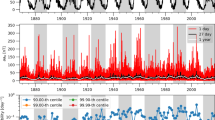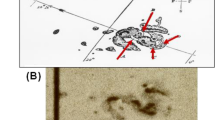Abstract
One of the large Sun–Earth connection events in solar cycle 23 occurred between 14 and 16 July 2000. Anomalies occurring on several satellites were reported in association with this event. Statistical study of extreme events is important not only for a view of space weather but for seeking ways to predict such kinds of large events. The Bastille Day event was characterized by a large flux (24 000 p.f.u. at its maximum) of solar energetic protons and a fast average transit speed of approximately 1500 km s−1 of the interplanetary disturbance. A geomagnetic Kp index of more than 9 was observed after an interval of approximately eleven years since 1989. We found that return periods of extreme space weather (e.g., large flares, solar energetic proton events, and large geomagnetic storms) satisfied the Weibull distribution.
Similar content being viewed by others
References
Cliver, E. W., Feynman, J., and Garrett, H. B.: 1990, J. Geophys. Res. 95, 17103.
Feynman, J. and Hundhausen, A.: 1994, J. Geophys. Res. 99, 8451.
Justus, C. G., Hargraves, W. R., and Yalcin, A.: 1976, J. Appl. Met. 15, 673.
Justus, C. G., Hargraves, W. R., Nikhall, A., and Graber, D.: 1976, J. Appl. Met. 17, 350.
Kosovichev, A. G. and Zharkova, V. V.: 2001, Astrophys J. 550, L105.
Reames, D. V., Ng, C. K., and Tylka, A. J.: 2001, Astrophys J. 548, L233.
Shea, M. A. and Smart, D. F.: 1990, Solar Phys. 127, 297.
Takle, E. S. and Brown, J. M.: 1978, J. Appl. Met. 17, 556.
Wang, H., Tang, F., Zirin, H., and Ai, G.: 1991, Astrophys J. 380, 282.
Weibull, W.: 1951, J. Appl. Mech. 18, 293.
Wong, R. K. W.: 1977, J. Appl. Met. 16, 1360.
Wülser, J.-P., Canfield, R. C., and Zarro, D. M.: 1992, Astrophys J. 384, 341.
Zhang, J., Wang, J., Deng, Y., and Wu, D.: 2001, Astrophys J. 548, L99.
Author information
Authors and Affiliations
Rights and permissions
About this article
Cite this article
Watari, S., Kunitake, M. & Watanabe, T. THE BASTILLE DAY (14 JULY 2000) EVENT IN HISTORICAL LARGE SUN–EARTH CONNECTION EVENTS. Sol Phys 204, 425–438 (2001). https://doi.org/10.1023/A:1014273227639
Issue Date:
DOI: https://doi.org/10.1023/A:1014273227639




